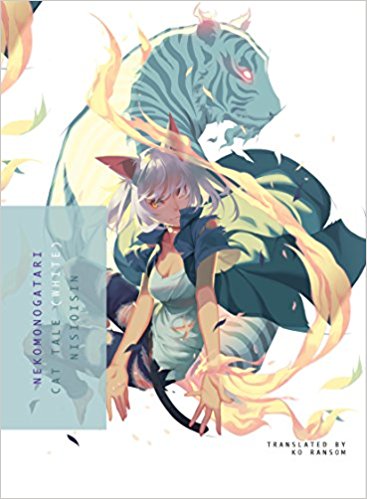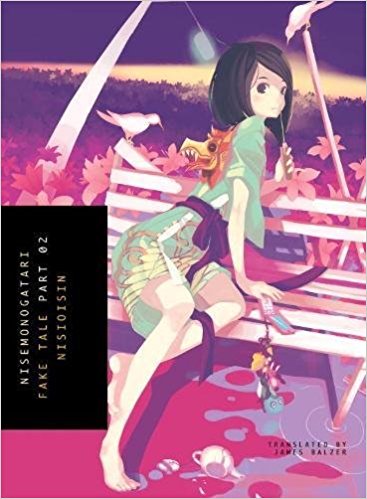By NISIOISIN. Released in Japan by Kodansha. Released in North America by Vertical, Inc. Translated by Ko Ransom.
This is the first volume of the Monogatari Series not to be narrated from the POV of Koyomi Araragi, and it makes a difference, although not as much as you might expect. Tsubasa Hanekawa is our narrator, and therefore the narrative is every bit as analytical and over-verbose as ever (given the actual author of the works, this is likely unavoidable). But there’s a certain sleaziness we’ve gotten used to with Araragi that is mostly absent here, despite Senjogahara’s best efforts to keep it around. We also get to see Hanekawa come to some critical realizations about herself. If Tsubasa Cat was about the reader seeing how messed up Hanekawa is, and Nekomonogatari Black was about Araragi seeing it, then this book is the finale, as Hanekawa has to finally realize what she’s really like and take steps to change it. And given that there’s a part of Hanekawa that wants to just sit back and let the world burn – quite literally – this is a tall order.
Despite the absence of Araragi’s narrative from the volume (indeed, Araragi himself doesn’t even show up until the climax), there are many familiar things going on here. There is a certain metatextual fourth wall breaking throughout, from Hachikuji cheerfully telling the reader that the next book will be about her (true, though also false – see the Kabukimonogatari review in 2 months) to Hanekawa noticing that there are missing chapters as the book goes on. There’s also a large amount of funny banter, mainly due to the burgeoning friendship of Hanekawa and Senjogahara. Senjogahara has become far more open since the series began, something Hanekawa herself observes, and almost takes on Araragi’s role here, flirting with Hanekawa constantly and at one point showering together with her. (One senses Nisioisin is now writing this knowing there will be an anime.) There’s also some unintentionally dark humor, such as Hanekawa blithely deciding to sleep in the abandoned cram school with cardboard boxes for bedding – her matter-of-fact narration of this is painful and hysterical.
The main thrust of the book is a new aberration, a large Tiger that is seemingly burning to the ground places Hanekawa has just slept – first the house she lives in with her “parents”, then the cram school itself. In reality, things are a bit more complicated, and it should not surprise any regular readers of the series to know that this aberration is more about Hanekawa’s repressed emotions – in this case, her envy of what it means to have a happy family. Deciding to stop pushing all of her negative emotions onto aberrations and simply deal with them instead is admirable, but it has to come at a cost, and in this case it’s finally confessing to, and getting rejected by, Araragi, which allows her to cry for possibly the first time in her entire life. This is the final volume of Hanekawa’s main story arc, and it’s a very good ending, even if she’s not leaving the main story just yet.
For anime fans, there are a lot of reasons to get this book. The uncut version of longer monologues provides greater depth of feeling – Hanekawa is allowed to outright state that her parents are abusive, and she also admits to herself that she’s fallen for Senjogahara too, but of course simply cannot get in the way of her relationship with Araragi. (OT3 fans will be both happy and sad, I expect.) And of course there is the usual good reason to get the books, which is to wallow in Nisioisin’s idiosyncratic prose, which may come from Hanekawa’s POV but is still present and correct. If you like Monogatari in general and Tsubasa Hanekawa in particular, this volume is essential.





